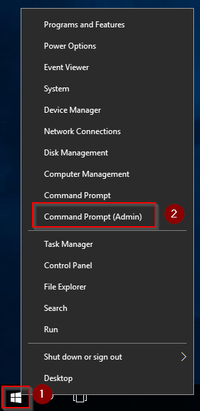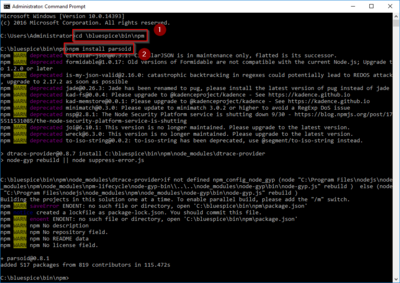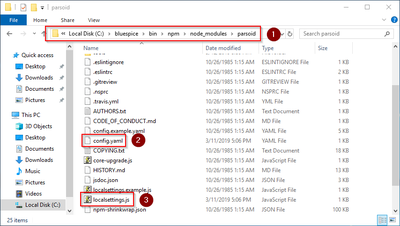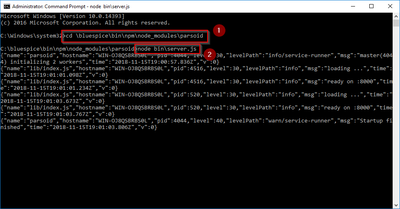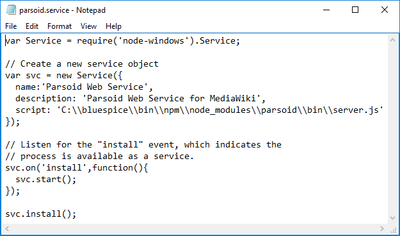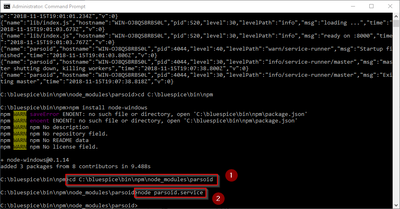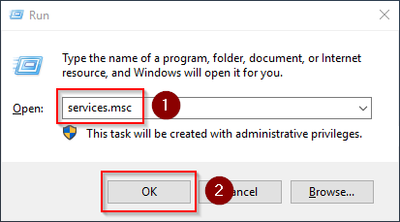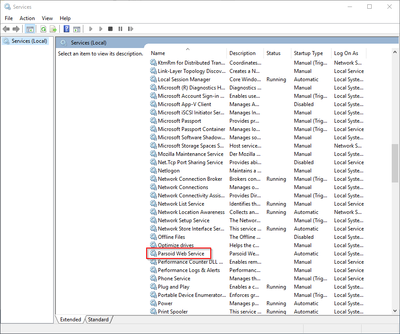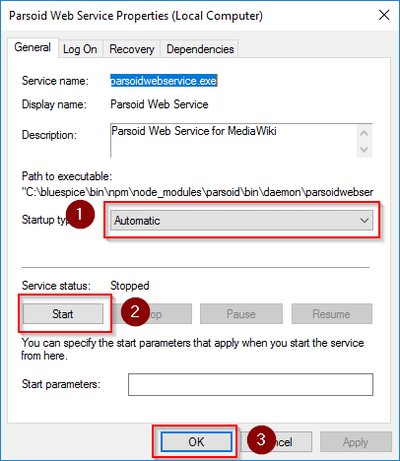Difference between revisions of "Setup:Installation Guide/System Preparation/Windows/Parsoid"
← Setup:Installation Guide/System Preparation/Windows/Parsoid
| [quality revision] | [quality revision] |
(Tag: Visual edit) |
(Tag: 2017 source edit) |
Contents
| Parsoid is the rendering service for the Visual Editor. The steps listed here are optional and only required if you want to use Visual Editor in your BlueSpice installation. After your BlueSpice Installation, you still have to activate VisualEditor. |
| For the installation and operation of Parsoid, Git and Node.js are required. If you have not installed them yet, follow the links that are provided here. |
Installing Parsoid[edit | edit source]
First, open the Windows Command Prompt as administrator. To do this, right-click "Start" (1) and select "Command Prompt (Administrator)" (2):
Change into the directory C:\bluespice\bin\npm (1) execute the command "npm install parsoid" (2):
Keep the command prompt open and complete the following step
Creating the configuration file[edit | edit source]
In the BlueSpice codebase you will find two files in the folder extensions/BlueSpiceVisualEditorConnector/docs/parsoid:
- config.yaml
- localsettings.js
Copy them into the folder C:\bluespice\bin\npm\node_modules\parsoid\.
This provides an already finished configuration of Parsoid, which should work in the standard setup without further iadjustments.
Parsoid installation and configuration check[edit | edit source]
To test the installation and configuration, go back to the command prompt.
Change into the directory C:\bluespice\bin\npm\node_modules\parsoid (1) and start the service with the command "node bin\server.js" (2):
The service should now start without an error message. For further review, call the URL "http://localhost: 8000" in Internet Explorer. You should see the following page:
Change back to the command prompt and quit Parsoid by pressing "Ctrl+C". Keep the command prompt open and go to the next step.
Installation as a service[edit | edit source]
To run Parsoid in the background in the future, you need to install Parsoid in a Windows service. To do this, proceed as follows:
In the command prompt, change to the directory "C:\bluespice\bin\npm" (1) and execute the command "npm install node-windows" (2):
Using a text editor, create the file "C:\bluespice\bin\npm\node_modules\parsoid\ parsoid.service" with the help of this linked content:
In the command prompt, change into the directory "C:\bluespice\bin\npm\node_modules\ parsoid" (1) and execute the command "node parsoid.service" (2):
You can now close the command prompt.
Then enter the key combination Windows+R.
In the following dialog box, enter "services.msc" (1) and confirm with "OK" (2):
Find the service "Parsoid Web Service" and open it with a double-click:
Select the startup type "Automatic" (1) and start the service (2). After the service is started, close the window with "OK" (3):
In Internet Explorer, check the URL "http://localhost:8000", as already explained in the previous step, whether the Parsoid service started successfully.
Next step[edit | edit source]
If you have completed all steps successfully, you can proceed to the next step " Python".
{{DISPLAYTITLE:Installing Parsoid on Windows}}
__TOC__
{{Template:Optional|text=Parsoid is the rendering service for the Visual Editor. The steps listed here are optional and only required if you want to use Visual Editor in your BlueSpice installation. After your BlueSpice Installation, you still have to [[Setup:Installation Guide/Advanced/VisualEditor Configuration|activate VisualEditor]].}}
{{Template:Hint|text=For the installation and operation of Parsoid, [[Setup:Installation Guide/System Preparation/Windows/Git|Git]] and [[Setup:Installation Guide/System Preparation/Windows/Node.js|Node.js]] are required. If you have not installed them yet, follow the links that are provided here.}}
==Installing Parsoid==
First, open the Windows Command Prompt as administrator. To do this, right-click "Start" (1) and select "Command Prompt (Administrator)" (2):
[[File:Setup:Parsoid_Install_01.png|center|200px|Parsoid Installation 01]]
Change into the directory C:\bluespice\bin\npm (1) execute the command "npm install parsoid" (2):
[[File:Setup:Parsoid_Install_02.png|center|400px|Parsoid Installation 02]]
Keep the command prompt open and complete the following step
==Creating the configuration file==
In the BlueSpice codebase you will find two files in the folder <code>extensions/BlueSpiceVisualEditorConnector/docs/parsoid</code>:
*config.yaml
*localsettings.js
Copy them into the folder C:\bluespice\bin\npm\node_modules\parsoid\.
[[File:Setup:Parsoid_Config_01.png|center|400px|Parsoid Configuration 021]]
This provides an already finished configuration of Parsoid, which should work in the standard setup without further iadjustments.
==Parsoid installation and configuration check==
To test the installation and configuration, go back to the command prompt.
Change into the directory C:\bluespice\bin\npm\node_modules\parsoid (1) and start the service with the command "node bin\server.js" (2):
[[File:Setup:Parsoid_Run_01.png|center|400px|Parsoid Testen 01]]
The service should now start without an error message.
For further review, call the URL "http://localhost: 8000" in Internet Explorer. You should see the following page:
[[File:Setup:Parsoid_Run_02.png|center|400px|Parsoid Testen 02]]
Change back to the command prompt and quit Parsoid by pressing "Ctrl+C". Keep the command prompt open and go to the next step.
==Installation as a service==
To run Parsoid in the background in the future, you need to install Parsoid in a Windows service. To do this, proceed as follows:
In the command prompt, change to the directory "C:\bluespice\bin\npm" (1) and execute the command "npm install node-windows" (2):
[[File:Setup:Parsoid_InstallService_01.png|center|400px|installing the Parsoid service 01]]
Using a text editor, create the file "C:\bluespice\bin\npm\node_modules\parsoid\ parsoid.service" with the help of [[Setup: Installation Guide/System Preparation/Windows/Parsoid/ parsoid.service | this linked content]]:
[[File:Setup:Parsoid_InstallService_02.png|center|400px|installing the Parsoid service 02]]
In the command prompt, change into the directory "C:\bluespice\bin\npm\node_modules\ parsoid" (1) and execute the command "node parsoid.service" (2):
[[File:Setup:Parsoid_InstallService_03.png|center|400px|installing the Parsoid service 03]]
You can now close the command prompt.
Then enter the key combination Windows+R.
In the following dialog box, enter "services.msc" (1) and confirm with "OK" (2):
[[File:Setup:Parsoid_InstallService_04.png|center|400px|installing the Parsoid service 04]]
Find the service "Parsoid Web Service" and open it with a double-click:
[[File:Setup:Parsoid_InstallService_05.png|center|400px|installing the Parsoid service 05]]
Select the startup type "Automatic" (1) and start the service (2). After the service is started, close the window with "OK" (3):
[[File:Setup:Parsoid_InstallService_06.png|center|400px|installing the Parsoid service 06]]
In Internet Explorer, check the URL "http://localhost:8000", as already explained in the previous step, whether the Parsoid service started successfully.
==Next step==
If you have completed all steps successfully, you can proceed to the next step "[[Setup:Installation Guide/System Preparation/Windows/Python | Python]]".
[[en:{{FULLPAGENAME}}]]
[[de:Setup:Installationsanleitung/Systemvorbereitung/Windows/Parsoid]]| Line 1: | Line 1: | ||
| − | {{DISPLAYTITLE:Parsoid on Windows}} | + | {{DISPLAYTITLE:Installing Parsoid on Windows}} |
__TOC__ | __TOC__ | ||

